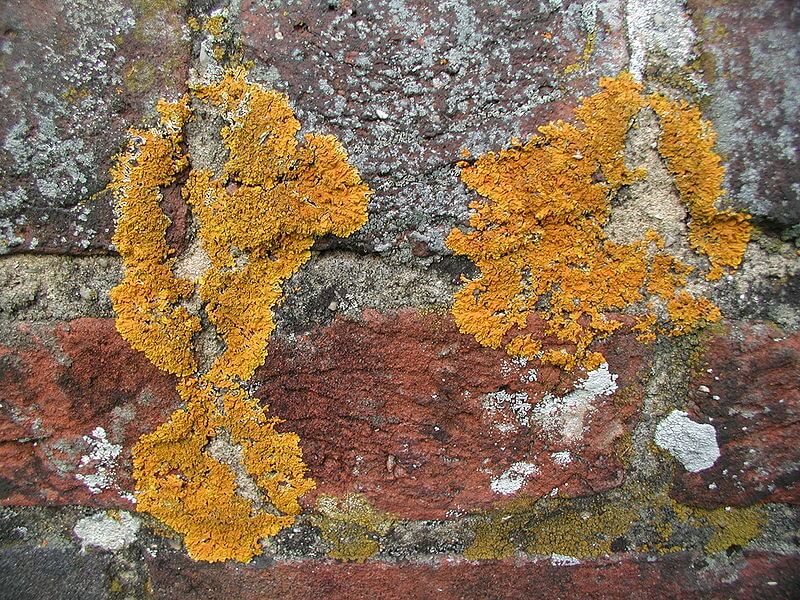Lichens: Nature’s Weather Instruments
by Erica Soon Olsen
Broadcast 10.1 & 10.4.2019

Crustose lichen – photo by Roger Cave, Flickr (CC 2.0)
Listen:
While walking on the Kim Williams trail just outside of Missoula, I found myself noticing the abundant growth of lichens on the cliffs beside the trail. The lower slopes of Mount Sentinel are home to a thriving lichen population. These tiny, crust-like organisms are actually a composite of two plants—fungus and algae—that live in a symbiotic, or mutually beneficial, relationship. Lichens are usually green or grey in color, but on the north-facing cliffs by the Clark Fork River, this subtle palette is brightened by shades of pumpkin orange. As I ran my hand over the rock, I noticed how hard, dry, and scaly the lichens felt. Unlike moss, which somewhat resembles grass, lichens seem more like part of the rock than living plants.
Crustose lichens are the kind that grow closest to the rock surface; they actually resemble tiny pebbles. If you pry off a fragment of this kind of lichen, you’ll find it as dry as dirt. Roll the lichen between your fingers, and it starts to crumble. But if you moisten it with a little water—a drop of dew, some rainwater, or even the moisture on your tongue—the lichen will transform. The dry, scaly crust will immediately become soft and flexible; its texture now resembles seaweed.
So with a little field experiment, I discovered that lichens are very thirsty organisms. But how do they drink? Although they commonly grow on a substrate of rock, soil or tree bark—and even have been known to grow on plastic, rusted metal, and old rubber tires—lichens do not take in water from these bases, they way most plants do with their roots. Instead, lichens are like sponges; they take in water over their entire surface. And lichens are thirsty indeed. It sounds like an ad for moisturizer: in just five seconds, the average lichen can absorb half the total amount of water it can hold.
Lichens don’t even need liquid water sources like rain or melting snow. They can absorb moisture directly from the air. You might think of them as natural weather instruments, because their ever-changing water content reflects the humidity of the air. Some lichens specially adapted to dry areas get all of their moisture from the air. Oddly enough, some of those lichens are completely unable to absorb liquid water; if you submerged them, they would remain dry.
The down side to lichen absorbency is that lichens dry out almost as fast as they get wet. The life of a lichen consists of this repeated cycle of wetting and drying. The drying process protects lichens from intense sunlight, which can hurt the algae portion of wet lichens. Yet on the other hand, as lichens dry, less light enters them and consequently they are less effective at photosynthesis.
For this reason, areas near water provide some of the best lichen-growing conditions. Near water, morning fogs can occur, providing an ideal combination of moist air and gentle light—just what lichens need for photosynthesis to take place. Another advantage is a location protected from direct morning sunlight, so that the lichens can drink up morning fog and dew before drying out. It’s not surprising, then, that the rock on the shady north side of Mount Sentinel, near the river, is home to such a healthy lichen population.
And so the seemingly dry, hard and unchanging lichens undergo a constant cycle of wetting and drying that usually escapes our notice. As I lingered near the lichen-covered cliffs, I gazed at the Clark Fork, and imagined the welcome moisture that the next morning’s fog would bring.
Every week since 1991, Field Notes has inquired about Montana’s natural history. Field Notes are written by naturalists, students, and listeners about the puzzle-tree bark, eagle talons, woolly aphids, and giant puffballs of Western, Central and Southwestern Montana and aired weekly on Montana Public Radio.
Click here to read and listen to more Field Notes. Field Notes is available as a podcast! Subscribe on iTunes, Google Play, or wherever you listen to podcasts.
Interested in writing a Field Note? Contact Allison De Jong, Field Notes editor, at adejong [at] montananaturalist [dot] org or 406.327.0405.
Want to learn more about our programs as well as fun natural history facts and seasonal phenology? Sign up for our e-newsletter! You can also become a member and get discounts on our programs as well as free reciprocal admission to 300+ science centers in North America!












